BibTeX | RIS | EndNote | Medlars | ProCite | Reference Manager | RefWorks
Send citation to:
URL: http://journal.zums.ac.ir/article-1-1218-en.html

 , Mohammad Hasan Taghavi2
, Mohammad Hasan Taghavi2 
 , Mansoureh Movahhedein3
, Mansoureh Movahhedein3 
 , Hamidreza Jafari Naveh2
, Hamidreza Jafari Naveh2 

2- Dept. of Anatomy, School of Medicine, Rafsanjan University of Medical Sciences, Rafsanjan, Iran
3- Dept. of Anatomy, School of Medicine, Tarbiat Modares University, Tehran, Iran
Background and Objective: Efforts to develop new methods for a safe male contraceptive have been made during recent decades, but the most reliable method is still sterilization by vasectomy. In this experimental study, effects of administration of testosterone in combination with ultrasound on contraceptive male mice were studied. Materials and Methods: 28 mature male mice were randomly divided into the following groups: normal group, testosterone group, ultrasound group and testosterone-ultrasound group. Animals were injected with or exposed to normal saline, testosterone enanthate, ultrasound and testosterone enanthate in combination with ultrasound respectively for 6 weeks. After this period, viability, motility rate and number of sperms were assessed. The morphometric parameters such as tubular diameter were also studied. Results: In the testosterone group, the number of sperms decreased significantly in comparison to the 1st and the 3rd groups (P ≤0.01). The percentage of sperm viability was significantly decreased in the testosterone group comparing to other two groups (P ≤0.001). In concern to the percentage of sperm motility, a significance difference was not observed. The diameter of seminiferous tubules and the number of spermatogonia were changed in ultrasound group. In this group, the compacted seminiferous tubules were seen, so the number of counted cells was increased. In the testosterone group, the epithelium height decreased significantly. Conclusion: It seems that the ultrasound did not have effect on the absorption of testosterone and the histological changes resulting from ultrasound may be mechanical and thermal.
Received: 2010/08/31 | Accepted: 2014/06/23 | Published: 2014/06/23
| Rights and permissions | |
 |
This work is licensed under a Creative Commons Attribution-NonCommercial 4.0 International License. |


